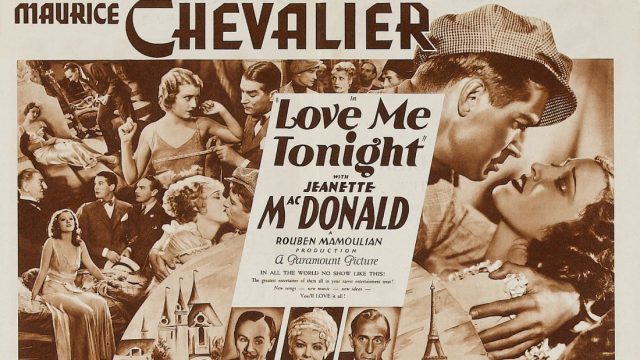Movies are miraculous. By the nature of their technology, they invent spectacular phenomena that otherwise defy the conventions of nature. When I was in elementary school, my teachers would occasionally project 16mm films, like The Red Balloon, backwards, just so we could see cause and effect turn into effect and cause (the “Ginger Rogers Effect”) with the reversal of time. To this day, I’m convinced that movies like Dziga Vertov’s Man With a Movie Camera are film school classics because the fun of seeing images sped up, slowed down, or superimposed over each other, is just too damn enjoyable to watch.
Rouben Mamoulian’s continental romantic musical, Love Me Tonight ends with a Vertovian homage, intercutting the hero’s pursuit of a train with inserts of whirring machinery and non-linear cutaways to power lines that violate classical norms of continuity. One would be hard pressed to say that this sequence was intended to provoke the audience’s political consciousness. It’s just cool. Produced in an era when sound technology largely subordinated the kinesthetic pleasure of the moving image, this movie simply revels in the possibilities of cinematic manipulation of physical reality.
The manipulation of sound and image, or more precisely, the use of aural effects to elasticize the visual sign, is Love Me Tonight’s signature motif. The film’s opening shots, for example, show numerous tradesmen going about their business in a small French town. As the film cuts back and forth between these vignettes depicting the daily routines of construction, transportation, and food production, the noises generated by these labors starts producing a polyrhythmic musical effect that subsequently segues into a full blown production number. The prosaic routines of daily life become transformed into something magical via the fantastical alchemy of editing and sound effects.
Mamoulian ups the game a few minute later when he introduces the film’s most famous song, “Isn’t It Romantic?” The song’s melody and lyrics pop into the head of a tailor (Maurice Chevalier) as he fits a client into a suit. After the client hums it to himself when taking a cab back home, the driver sings it to another passenger, a songwriter, who then cops the song as his own. While he’s working on it on his piano, the tune is overheard by a pedestrian about to join the army. Following a wipe, a whole regiment starts singing the song during a march, presumably as a replacement to “Do Wah Diddy.” Anyway, yada, yada, yada, a gypsy violinist soon plays it as a serenade which gets heard by Chevalier’s future object of desire (Jeanette MacDonald), a princess who brings the sequence to a close by singing the whole number in her trademark operatic warble.
Throughout this segment, the song is played in temporal continuity, with shifts in vocal and musical arrangement based on the character or instrument on screen. The images, however, are edited in a discontinuous way, more like the flow of a newsreel. The film generates a playful disjunction between linear time with the music and sequential choppiness with the visuals. Is this subtle? No. Is it delightful? Most definitely. As the film progresses, the experimental interplay between the picture and the music continues, with musical jokes utilizing split screen images and the shot/reverse angle convention coming into play.
Love Me Tonight follows the path of earlier films inspired by the operettas of Victor Herbert, which were cinematically perfected by Ernst Lubitsch, who headed up production at Paramount Pictures when this movie went into production. While Lubitsch’s films, such as The Love Parade and The Smiling Lieutenant developed mischievous sexual innuendos through smooth, transitional editing, Mamoulian emphasizes the brash and vulgar. This nicely unsettles our expectations, as it mixes the continental sophistication of the film’s luxurious settings in castles and mansions with a kinesthetic slapstick of sound and image. Near the end of his career, the director would return to the elegant musical with Silk Stockings. In that picture, the grace of Fred Astaire’s dancing can’t be denied, but it can also be argued that the more polished aesthetic lacks the surprise and energy of the earlier genre entry. Love Me Tonight attempts to do more than simply allow the camera to record a performance. It tries to subject the musical to the new relationships between sight and sound that celluloid provides.

